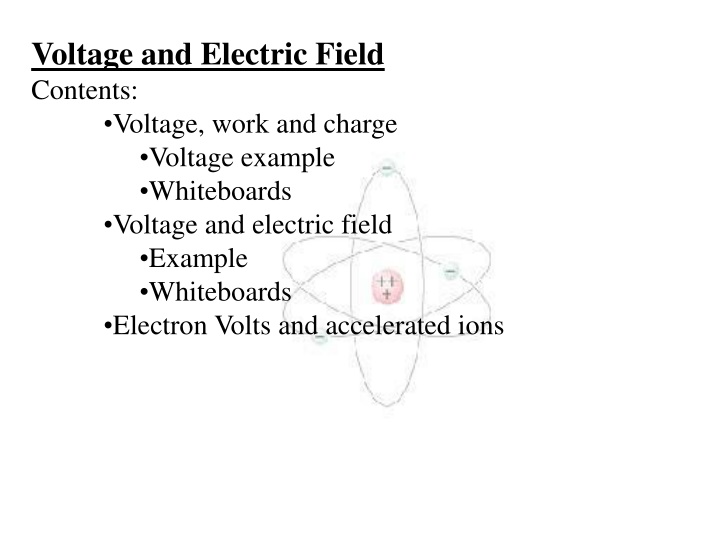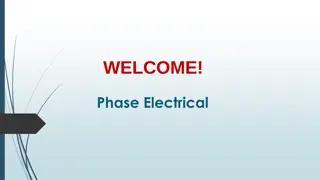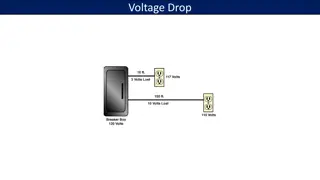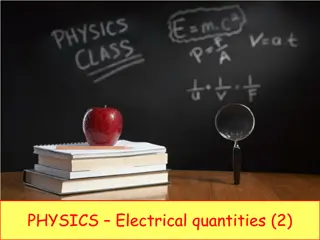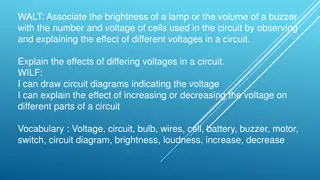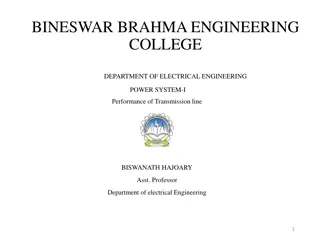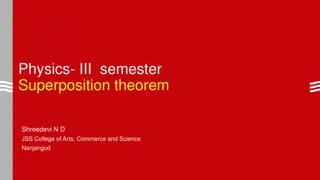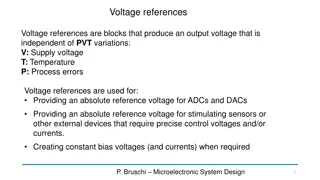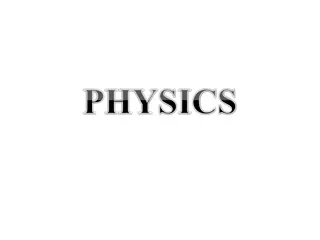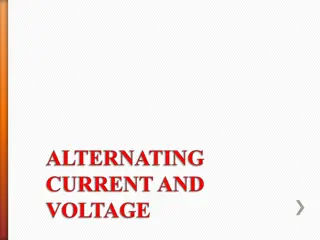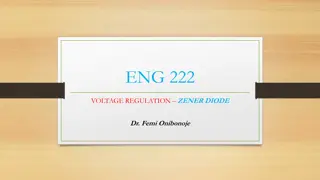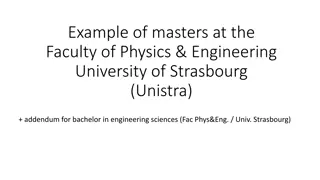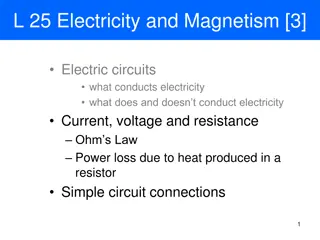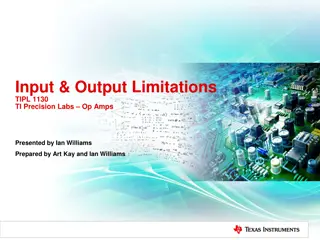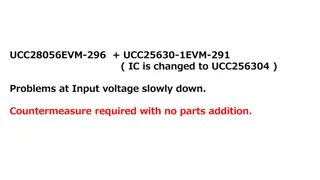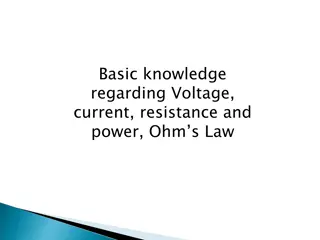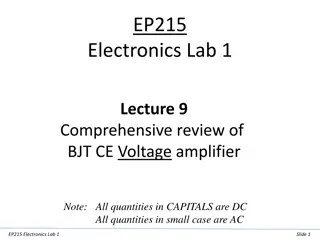Voltage and Electrical Potential in Physics
Explore the concepts of voltage, electrical potential, work, and charge through practical examples involving moving charges against electric and gravitational fields. Learn how to calculate voltage, work done, and gravitational potential changes in various scenarios. Dive into the world of electrical circuits and potential differences to enhance your understanding of fundamental physics principles.
Download Presentation

Please find below an Image/Link to download the presentation.
The content on the website is provided AS IS for your information and personal use only. It may not be sold, licensed, or shared on other websites without obtaining consent from the author.If you encounter any issues during the download, it is possible that the publisher has removed the file from their server.
You are allowed to download the files provided on this website for personal or commercial use, subject to the condition that they are used lawfully. All files are the property of their respective owners.
The content on the website is provided AS IS for your information and personal use only. It may not be sold, licensed, or shared on other websites without obtaining consent from the author.
E N D
Presentation Transcript
Voltage and Electric Field Contents: Voltage, work and charge Voltage example Whiteboards Voltage and electric field Example Whiteboards Electron Volts and accelerated ions
Electrical Potential (AKA Voltage) Definition: V = W q V = Change in Electrical potential (Volts) W = Work (J) q = Charge (C) Voltage is like pressure, Air = 10,000 V/in, Show, Pickle-luminescence, Zap-O-Rama
Hans Full does 0.012 J of work on 630 C of charge moving it against an electrical field. What is the change in voltage? Jerry Rigg moves a 2.0 kg object upwards doing 64 J of work. What is the change in gravitational potential? (32 J/kg) (19 J/C or 19 V) show units
Whiteboards: Potential, Work and Charge/Mass 1-5
Sandy Deck does 125 J of work on a 12.5 C charge. Through what voltage did she move it? V = Ep/q, Ep = 125 J, q = 12.5 C V = 10.0 V 10.0 V
Lila Karug moves a 120. C charge through a voltage of 5000. V. How much work does she do? V = Ep/q, q = 120x10-6 C, V = 5000. V Ep = 0.600 J 0.600 J
Benny Hana does 45.0 J of work on 5.0 kg of mass moving it against a gravitational field. What is its change of gravitational potential? solution 9.0 J/kg
Jane Linkfence moves a mass through a potential difference of 320 J/kg and does 16 J of work. What is the mass? solution 0.050 kg or 50. grams
Arthur Moore does 0.167 J of work moving an unknown charge through a voltage of 12.1 V. Please, please, won t you please help him calculate the charge? V = Ep/q, V = 12.1 V, Ep = 0.167 J q = 0.013801653 = .0138 C = 13.8 mC 13.8 mC
Voltage and distance and E Field Definition: (derive) E = - V r E = Electric Field V = Voltage change r = displacement over which it changes (Why the minus sign) E + + + + + + + + + + - - - - - - - - - - r Parallel Plates
If you have a gravitational field strength of 9.81 N/kg, what is the change of gravitational potential in a vertical upward distance of 1.85 m? What is the electric field when you have 12.0 V across two || plates that are separated by 0.0150 m? (18.1 J/kg) (800 V/m) show units = N/C
Whiteboards: Potential, Field, and distance 1-5
Lee DerHosen places a voltage of 25 V across two || plates separated by 5.0 cm of distance. What is the electric field generated? Which way is the field? + + + + + + + + + + - - - - - - - - - - 5cm +25 V 0 V Parallel Plates 5.0x102 V/m right
Art Zenkraftz measures a 125 V/m electric field to the left between some || plates separated by 3.1 mm. What must be the voltage across them? Which side is the positive? E 3.1 mm Parallel Plates 0.39 V, right side is +
Helen A. Handbasket lifts a mass upwards (on earth) increasing its gravitational potential by 142 J/kg. What vertical distance did she lift it? 14.5 m
An electric field exerts a Southerly force of 3.30 N on a +450. C charge. What is the change in potential if you displace yourself 7.30 m to the North? Is it an increase, or decrease in potential? +53,500 V, increase
A gravitational field exerts a force of 126. N on a 13.0 kg mass away from point B and toward point A that is vertically displaced from B a distance of 12.0 m. What is the field strength? In what direction? What is the change in gravitational potential if you go from B to A? 9.69 N/kg, toward A, -116 J/kg
A uniform electrical field changes electrical potential from 110. V to 370. V when you move down 6.10 m. What is the magnitude and direction of the electrical field, and what force does it exert on a -1.40 C charge? 42.6 V/m. up, 5.97x10-5 N down
If you move a mass vertically from point A to point B, the potential changes from -65.0 J/kg to -34.0 J/kg in a distance of 17.0 m. What is the gravitational field strength? Does the field point toward A or B? Which point is at a higher elevation, A or B? 1.82 N/kg toward A, B is higher.
Carson Busses needs to suspend a 1.5 g (.0015 kg) pith ball against gravity. (gravity = electric) It has a charge of +12 C, and he is generating the electric field using plates that are 3.5 cm apart. What voltage should he use? Which side (top or bottom) is positive? E = - V/ x, F = Eq, F = mg mg = Eq = Vq/ x V = 42.875 V = 43 V Bottom positive +Q 43 V, bottom
Mimi O Graf is on planet Xzrstlnr. If she increases the gravitational potential of a mass by 95.0 J/kg in a vertical distance of 12.0 m, what is the gravitational field strength? sol 7.92 N/kg
Oliver Goodguy needs to generate a 13 V/m electric field using a 1.50 V source. What distance should he separate || plates to generate this electric field? E = - V/ x, V = 1.50 V,, E = 13 V/m x = 0.1154 m = 0.12 m = 12 cm 12 cm
